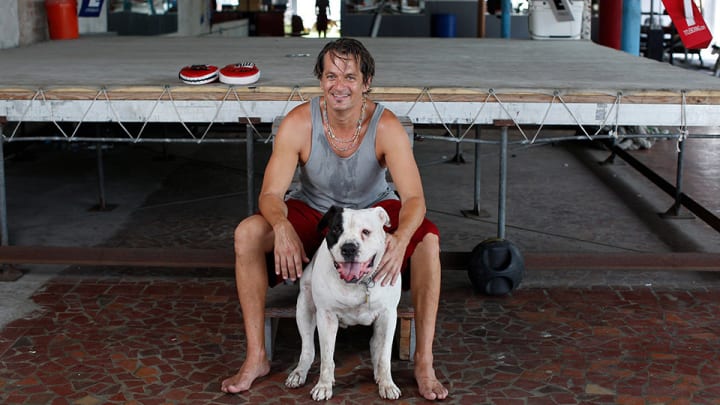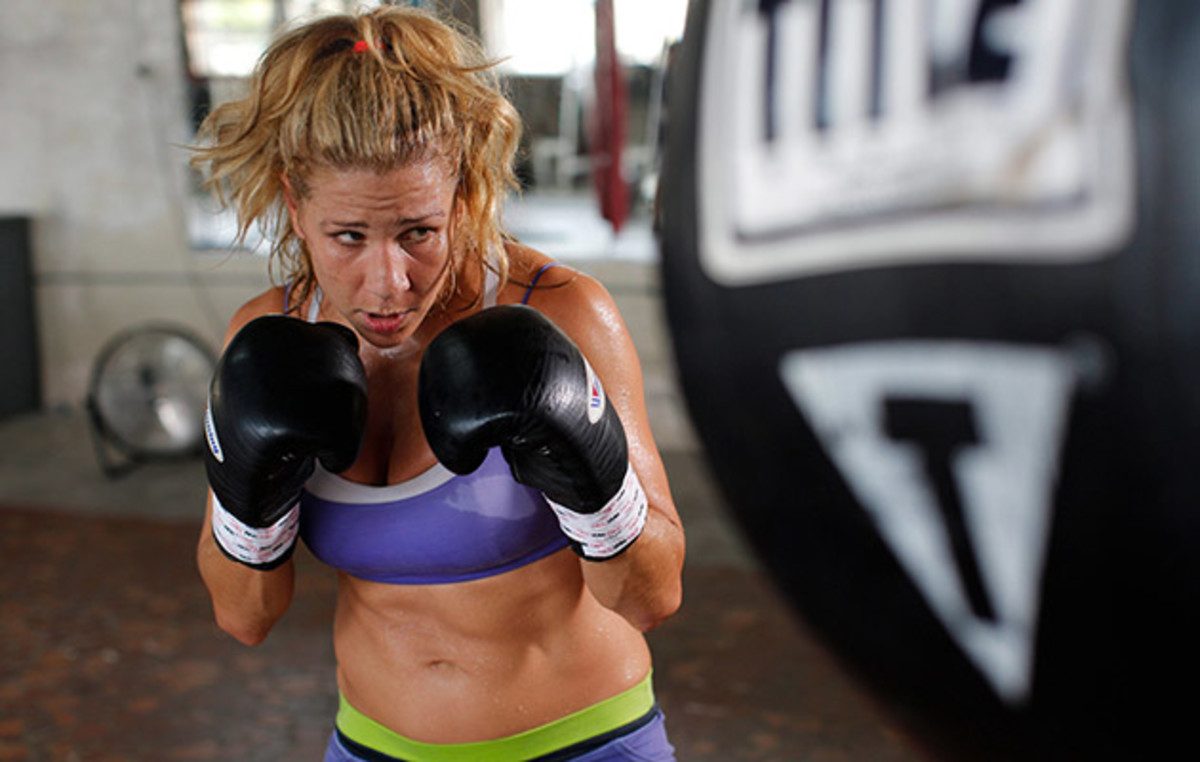A thriving gym, open-air fights put the spirit of New Orleans on full display

NEW ORLEANS — A couple of years back, when he was in this city filming the boxing comedy Grudge Match, Sylvester Stallone came to Friday Night Fights Gym. He was looking for a gritty, “authentic” location, and Mike Tata’s Central City setup, with its concrete floor, peeling walls and tattered ring, fit the bill. (Never mind that the film ostensibly took place in Pittsburgh.)
“He shot here some,” says Tata. “But then he wanted to lower the speed bag on the wall so he could reach it better. I told him to stand on a box like everybody else.”
That was the last Tata saw of Stallone. But now, in a show-biz twist of his own, the 53-year-old Tata is pitching a reality series centered on his gym and the semi-regular outdoor boxing shows he stages. Tata’s is a suitably Rockyesque, up-from-the-canvas saga. It’s also one tied from the beginning into the singular rhythms and resilience of New Orleans.
After owning a gym for seven years in New York City, Tata bailed on Manhattan’s soaring rents and moved to New Orleans in 2003. “I’d lived in New York and L.A.,” he says, “and I’d heard there was only one other place in the country as unique and interesting, and that was New Orleans.” He opened the Freret Street Gym, named after its address, a depressed retail strip in the Uptown section. It was January 2005, eight months before Katrina. Forced to evacuate after the storm, Tata says that he never thought of throwing in the towel. “We were the first commercial business to reopen on Freret,” he says. “I knew people wanted to keep punching.”
Playground legend: Antawn Jamison helps rebuilding effort after Katrina
The fighting spirit goes back a long way in New Orleans, and so does boxing. In 1892, Jim Corbett knocked out John L. Sullivan to win the heavyweight championship of the world in the 21st round of a bout held at the Olympic Club, a storied 3,500-seat arena on Royal Street in Ninth Ward, now long gone. In the decades after that the city hosted numerous title fights and produced such champions as Ralph Dupas and Willie Pastrano. And in 1980, the Superdome was the site of Roberto Duran’s infamous no mas moment against Sugar Ray Leonard. But since then, as big-time bouts gravitated increasingly to Atlantic City and Las Vegas, the sport became marginalized in cities across the country. New Orleans was no exception.
Tata, however, like the hero of any good boxing storyline, would refuse to go down for the count. Though forced to relocate to Oretha Castle Haley Boulevard (named for the civil rights leader of the 1960s and known as O.C. Haley Blvd. to the locals) in 2012—displaced not by rising waters but by rising rents along newly fashionable Freret—he has continued to stoke something of a rebirth in the New Orleans boxing scene.
In the past five years a number of other boxing gyms have opened in the city, from Treme to Mid-City to the Lower Ninth Ward, some catering more to the boxing-for-fitness movement that appeals to the many 20-somethings who have poured into New Orleans in the decade after the storm, but others offering kids from the city’s still damaged and dangerous neighborhoods an old-school alternative to what might await them on the streets (and, in the process bringing new life into the sport).
For now, though, it is Tata’s quarterly Friday Night shows that provide the most life. They started at Freret Street Gym but have soared in his new spot. Each of these only-in-Nola extravaganzas—think Mardi Gras meets The Contender—features eight bouts sanctioned by USA Boxing. The fights are held in a ring set up outdoors between a Burger King and a bar just off St. Charles Avenue and draw diverse crowds of more than 1,000 BYOB-fueled fans who are also treated to between-bout entertainment from singers, rappers, burlesque dancers and drag performers. There’s always a beauty contest too, open to women and men.
For both the boxers and the performers, each Friday Night Fights showcase offers a chance to step up to the big time.
But it’s a tough stage. Says Tata, “If you can’t dominate in your bout, you aren’t going to be going on to fight on ESPN or HBO. And, as a singer or a rapper, if you’re not killing it here, you won’t be playing the House of Blues next month.”
Still, the FNF audience (tickets are $15) gets its money’s worth. At one edition a few years ago a young man attempted to jump over the ring on a motorbike. Like many a pugilist in the past, he found himself on the ropes. Fortunately there were mats laid down to pad his landing.
“He didn’t make it,” says Tata gleefully, “but he lived to f------ tell the story.”

For many participants—New Orleanians all, whether fighter or rapper or drag queen—that is the point: to get out there in the spotlight in the elevated ring alongside St. Charles, with the streetcar rattling by and the crowd cheering and the music playing and give it your best shot, to take a puncher’s chance.
“There are two kinds of people who come,” Tata says. “Those who want to watch the show and those who want to be part of the show.”
That, of course, applies to a lot of life in this city. For the men and women toiling away on a recent sweltering afternoon in Friday Night Fights Gym, though, the focus is clearly on doing, not watching. With Tata’s big white American bulldog-pit bull mix, Mr. T., patrolling the periphery, the battered, high-ceilinged space clatters with activity. There is 22-year-old middleweight Asani Woods, preparing for an amateur card out of town; there is 28-year-old Wayne Banks, newly released after 13 years in prison, who said he was “just trying to get my body back;” and there is criminal defense attorney Bobby Hjortsberg, a Friday Night Fights veteran now hooked on the sport. And, up in the ring, there is former WBC super welterweight champion Tiffany Junot, working the mitts with her trainer, Aaron Navaro.
How sports have helped New Orleans heal in decade since Hurricane Katrina
Junot, 36, is a New Orleans native, born and raised in the Algiers Point neighborhood just across the Mississippi, and she carries a fierce pride in her hometown. A decorated amateur, she was on the U.S. team scheduled to compete in the 2005 world championships when Katrina hit. She was forced to evacuate and stayed for a while at the Olympic Training Center in Colorado Springs before relocating to Houston and then turning pro. Though the boxing scene was far more established in Houston, Junot continued to shuttle back and forth between there and New Orleans. In 2011, she came home for good. The following year she beat her onetime inspiration Mia St. John for the WBC female junior middleweight title. Junot still travels to Houston regularly to work with Navaro and to get access to top-level sparring partners, but she says her heart is New Orleans. She runs every day along the levee beside the Mississippi and trains in Friday Night Fights Gym.
“This city just needs to see what’s possible,” Junot says between rounds, referring to the emerging Nola boxing scene—and in a way, to so much more. Looking around the gym, she adds, “There’s so much desire here, so much strength.”
The bell rings, and she slides out into the ring to resume punching.
